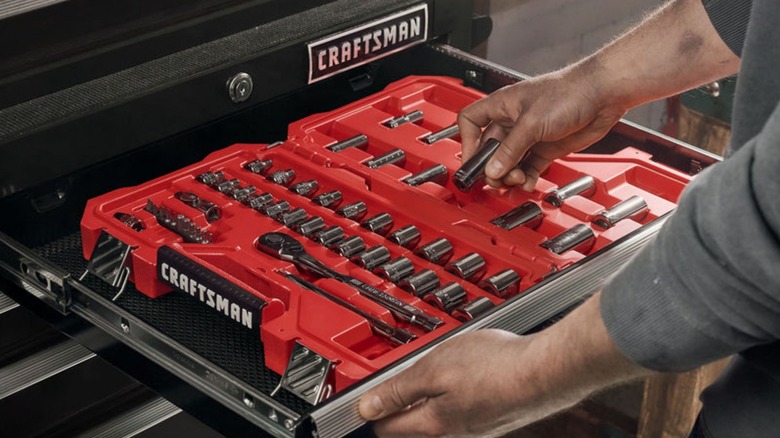How To Remove The Drawers From Your Craftsman Toolbox
Craftsman has been one of the biggest names in American tool manufacturing since the company made its debut in the 1920s. But as popular as its hand and power tools are, the company is also known for making quality metal toolboxes to hold them. In fact, many consider Craftsman to be one of the best tool chest brands on the market.
But sometimes even the best tool chests need to be taken apart. You might have a tool fall behind a drawer, a spill that seeps into the chassis, or even a family of tiny critters that decide your toolbox is a great place to call home. Whatever the reason, there may come a time when you have to remove the drawers from your Craftsman toolbox. This can be tricky, however, as the drawers are designed to lock in place before sliding all the way out. This is usually a good thing, as it prevents large drawers full of heavy tools from falling to the ground, possibly damaging the drawer, the tools, and even potentially injuring the person holding the handle.
That said, there is a way to do it. All you need is a bit of patience and, in some cases, a flathead screwdriver.
Most new Craftsman toolboxes use ball-bearing drawer slides
Most modern Craftsman tool chests use a ball-bearing drawer slide mechanism that is similar to what you might see on models available from many other brands. There is a metal guide bracket attached on either side of the drawer that slides into another (usually silver colored) retractable metal sliding bracket that partially moves with the drawer while also remaining fixed inside the chassis. The secret to removing the drawer from the toolbox lies in separating these two brackets.
To do this, start by fully extending and removing everything inside the drawer. Some of Craftsmen's models will have a release lever on either side where the bracket attached to the drawers slides into the bracket attached to the chassis. On these models, you'll simply need to lift or lower the release lever on both sides while supporting the weight of the shelf, and then pull. The drawer should then slide out easily.
Other models may have tab-style latching mechanisms that lock between the two brackets. These have metal or plastic pieces attached to the inside of the drawer bracket that catch on a triangular-shaped indent in the fixed bracket attached to the chassis. This indent is called a lance. To unlock these tabs, simply open the drawer all the way, push it back ~¼-inch, and then depress the tabs through the small rectangular (or oval-shaped) window just before the latch. These openings can be quite small, so you may need a flathead screwdriver to depress them if you can't do it with your fingers. A popular method for doing this more easily is to slide the screwdriver through the triangular opening and then rotate it 45 degrees out, depressing the tab and sliding it past the lance in a single fluid motion.
Older craftsman toolboxes might have friction slide drawers
While it's true that most newer Craftsman toolboxes use the aforementioned ball-bearing drawer slide mechanism, there are several older models that use friction slides. These have fewer moving parts and therefore fewer failure points, but they move on tracks that are held together via metal-on-metal contact, relying on friction to hold them in place, and don't slide as easily. This is why you aren't likely to find them on most of the Craftsman tool chests you can buy for your garage today. Fortunately, removing the drawers from these kinds of toolboxes is usually pretty easy, so long as they're still in good shape.
Drawers with these older friction stops can come in a couple of varieties. Some of them have tab-style latching mechanisms similar to many of the ones used in the ball-bearing style models. These can often be opened using the same technique sited above, though some people have found that the best way to remove them is by inserting a thin piece of metal, like a hacksaw blade, the metal hanger from a file cabinet folder, or a strip of sheet brass or aluminum, into the gap between the two brackets. This allows the internal tab to slide along the strip of metal past the lance.
Other models may have a pivoting tab on the outside of the outer sliding bracket, which is even easier to work with. These tabs can be pried up with a screwdriver on either side of the drawer to release the catch. Once you've pried both tabs forward, you should be able to wiggle the drawer loose, though they can sometimes snap back into place if you aren't careful.
